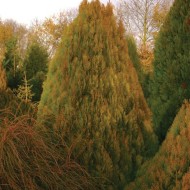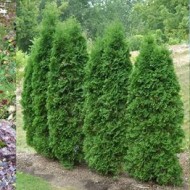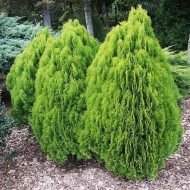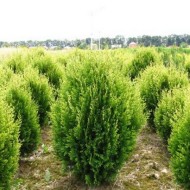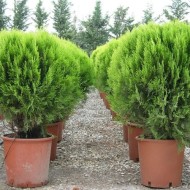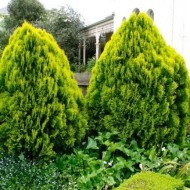Features and rules for growing thuja eastern in the country: advice from professionals
Content
Description of thuja eastern
Another name used by reference books on botany is flatworm. This is due to the lamellar structure of the shoots with many small needles that grow on several trunks and form a pyramidal shape, especially in the early years of growth. In the future, the branches grow, forming a more rounded crown.

The birthplace of culture is North China. Biota is even considered a symbol of Beijing. The eastern thuja grows very slowly, perhaps that is why the life expectancy of the plant is more than 150 years. The height of mature trees reaches 15–20 m, and under favorable conditions the tree grows up to 35 m. The crown diameter grows to 10 m or more.
The biota is classified as a coniferous plant of the genus gymnosperms of junipers. Cypress, sequoia, taxodium and juniper are considered relatives of thuja. When decorating the landscape, the eastern Tuyu is used as a hedge. For this, various varieties are grown with different shades.
Video "Causes of yellowing of tui"
In this video, the expert will talk about the reasons for the yellowing of thujas, and also share his experience of caring for the plant.
Common varieties of biota
This type of cypress crop has 6 varieties that differ from each other.
Nana Aurea
This plant is often used in landscape design. It has a height of up to 2 m, and reaches 70 cm in diameter. It is called the “tree of life” for its very slow growth (5 cm per year) and longevity. Botanists claim that this variety can cross the millennium milestone.
Nana Aurea prefers to grow in sunny, well-lit areas. Placing it on the shady side of the building, it will be noticeable how the crown begins to thin out, and the plant withers. In summer, the shoots of the biota will have a golden hue, and in winter they will shimmer with bronze flowers.
Yustinka
Together with Aureai, this variety is referred to as dwarf. Bred by Polish breeders, Yustinka has a columnar shape and an annual growth of 10–11 cm. The formed branches are directed straight up and are the backbone for fan-shaped branches of a dark green color. Unlike the previous variety, Yustinka is frost-resistant.
Morgan
The achievement of Australian breeders distinguishes this variety from others by the brighter color of the needles, which is inherent in the spring-summer period with a bright emerald hue. In winter, the color changes to bronze-reddish or orange.The pyramidal crown, pointed in the upper part, is saturated with dense vegetation of shoots and does not need to form a contour.
Platycladus
The annual growth of this variety reaches 15 cm. It is grown in the form of lush bushes of bright green color with a conical crown. Mature trees grow up to 10 meters in height, and the trunk diameter is up to 1 m.
Pyramidalis
A rare variety of biota that painlessly tolerates being in the shade. In spring, the shoots of the plant are prone to sunburn. To avoid this, it is recommended to cover the bush with agrofibre during the early snowmelt period. The culture has the shape of a narrow column, reaches 4 meters in height with a crown of 0.8–1.5 m. The yellow color of flat-leaved trees does not change throughout the year.
Golden Minaret
A frost-resistant variety, but requires protection from drafts and strong winds. Has a yellow tint, which changes to green when the plant is located in the penumbra. Comfortable conditions are created by mulching the trunk circle with peat or tree bark. It grows up to 3-4 m with a crown 1-1.5 m in diameter.
- Golden Minaret variety
- Thuja varieties Pyramidalis
- Thuja Platycladus variety
- Thuja Morgan variety
- Thuja variety Yustinka
- Nana Aurea variety
Planting subtleties and cultivation features
Such varieties of oriental thujas, such as Harmony, require timely and proper care, especially in the early stages of growth.
Determination of landing dates
Summer residents can plant thuja on the site in any of the summer months. But in order for the plant to better adapt to the place of deployment before frost, planting is recommended to be carried out in early May. If it was not possible to do this in the spring-summer period, then mid-September will be the deadline for the biota to be able to endure the frosty weather.
Light and humidity requirements
When determining the planting site, you need to take into account the photophilousness of the biota and remember that only some varieties are able to feel comfortable in the shade.
Having abundantly saturated the soil with water, the procedure is repeated at least once a week - until the seedlings are young. Between waterings, tree crowns are irrigated 1 or 2 times a week. In this case, the specifics of the land in which the planting was made is taken into account.
Ground requirements
The biota takes root well on clay, peat and boggy soils, where the requirements for irrigation are softened. When transplanting an adult plant, there are no great requirements for the soil. And when planting seedlings, a special composition is prepared from two parts of turf and one part of sand. The compositions are mixed and the prepared hole is poured, which is dug to a depth of 0.8–1 m. At the bottom, drainage is made using coarse gravel or other improvised means.
Landing algorithm
As with the cultivation of any crop in the local area, you must adhere to the following rules:
- set a landing date, May is considered optimal;
- choose a place, preferably sunny;
- mark the location of trees, dig holes for them;
- plant trees, covering the roots with pre-prepared soil, water abundantly;
- in the first few years, ensure regular watering of the root system and irrigation of the biota crown.
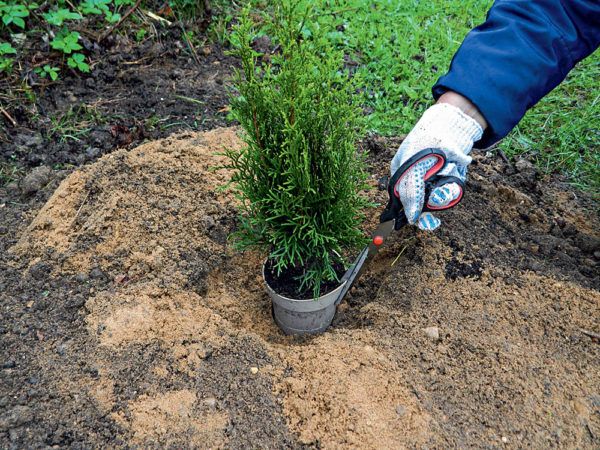
Watering and feeding mode
Eastern thuja is fed in spring. For this, complex fertilizers on a mineral basis are used. If those were used during planting, then the next top dressing can be done in two years.
In no case should the biota be fertilized with fresh manure - this will adversely affect the root system and painfully affect the tree itself.
An important thing when caring for thuja is the mode of maintaining humidity.In addition to regular weekly watering of the root system, irrigation of the crown is a mandatory procedure, especially in the first years of the plant's life.
Pruning and shaping the crown
After the seedling is three years old, the crop is pruned. Such work is performed in the summer. The painlessness of this procedure allows you to form the desired crown contour, which will easily fit into the landscape of the local area. Dry branches are removed regardless of the age of the tree and the season.
Preparing for winter
Saplings up to five years old are spud up to a great height, and the near-trunk space is covered with peat. To insulate a young tree, it is wrapped in a non-woven cloth or covered with spruce branches for the winter. Some gardeners try to cover the eastern thuja with snow in winter, but such measures rarely give the desired result.
If cracks are found on the tree trunk in the spring, then they are sealed with garden pitch, then they make sure that these areas are healed. The biota is not very adapted to frosts below the 20-degree mark. Only some varieties are characterized by increased winter hardiness.
Breeding methods for eastern thuja
As befits most ornamental plants, biota reproduces by dividing the bush, cuttings and seeds.
Growing from seeds
To grow thuja in this way, seeds are harvested in autumn and stored in a cool place until spring. Such storage will be similar to the natural finding of seeds under the snow. With the onset of spring, furrows up to 1 cm deep are made in the soil, into which the seeds are placed.
To preserve moisture, they are covered with peat or sawdust. After the first shoots appear, the bed is mulched, and mineral-based fertilizers will help the seedlings grow stronger in the first stages of life. Fertilizers are applied no more than 2 times a month while maintaining a low concentration of minerals.
During the first season, seedlings will rise no more than 5–8 cm. Young trees are transplanted only after the onset of the third spring.

Cuttings
In early June, planting soil is prepared from a mixture of turf, peat and earth. Then two-year-old cuttings are broken off together with the "heel", and the place of the break is treated with a special growth stimulator. After that, the twigs are buried in the planting mixture and covered to maintain a humid microclimate.
Every day the film is raised for airing, increasing the period of exposure of the cuttings to the air. In this case, the soil is not watered, but irrigated.
For the winter, young cuttings are covered with dry leaves to protect them from possible freezing.
Dividing the bush
The multi-stem structure of the eastern thuja allows you to divide the bush of a young plant and, without much effort, get two instead of one tree at once. This procedure is best done in the spring. It is not worth digging up a seedling completely. It would be best to free half of the roots and neatly cut the lower stem of the biota.
Possible difficulties in growing thuja
A heat-loving plant is susceptible to the influence of unpleasant environmental factors. It can suffer from pests and diseases, and its appearance will lose its attractiveness. It is important to identify the problem in time and solve it.
Common diseases
Like most junipers, flat leaves are prone to the following diseases:
- late blight;
- brown shute;
- fusarium.
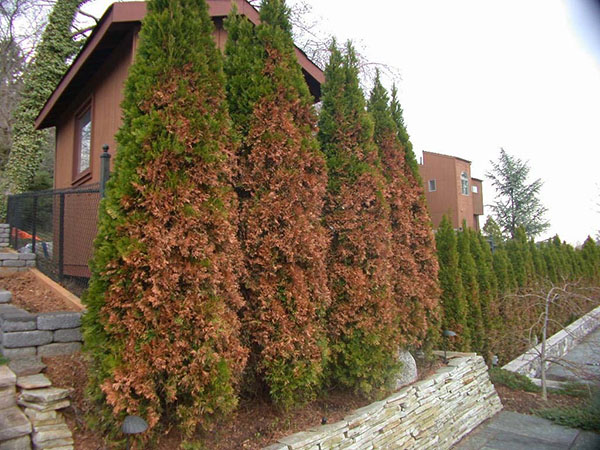
Each of these diseases manifests itself externally as yellowing and drying of the shoots. In order to avoid the death of the plant, preventive measures are taken, such as the treatment of roots with limestone, and the crown is sprayed with "Zircon" or "Fundazol".
Invasion of pests
A serious enemy of thuja is a false shield and aphids. The defeat of the shoots, which is noticeable by the growing yellowing, can destroy the biota. To overcome small pests, use such chemicals as "Antio", "Karbofos", "Rogor".
Other problems
Improper planting, as well as improper care, can cause the leaves to turn yellow or the shoots to dry out. Excessive soil moisture and frequent feeding lead to rotting of the root system. Clarification of individual shoots indicates a lack of iron, and the bark turns black when the seedling is tagged by cats or dogs. All this must be carefully monitored in order to protect the flat-leaved tree from harmful effects.
A description of the various types of eastern thuja, the peculiarities of growing and caring for it will help gardeners to embellish their summer cottage and make a landscape that will be remembered for dear guests.
Cultivate various types of cypress crops in your backyards, from dwarf oriental varieties to western giants such as Semperaurea. Let these plants bring positiveness to your life and add good mood, regardless of the season and weather.

